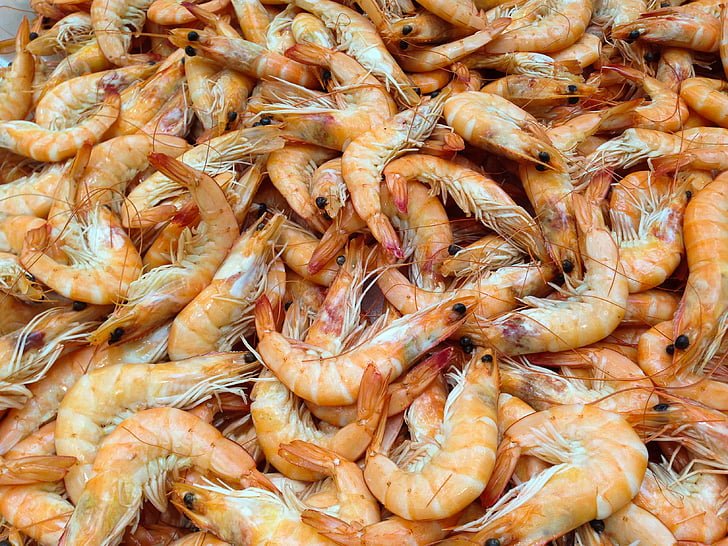Can a Dog Eat Shrimp? A Comprehensive Guide for Pet Owners
we want to know which human foods are safe to share with them. One question that often comes up is whether dogs can safely eat shrimp. While this seafood is enjoyed by many people, its suitability for dogs depends on how it’s prepared and served. This article will provide an in-depth look at shrimp’s nutritional benefits and risks for dogs, as well as some safe ways to introduce it into their diet.

Is Shrimp Safe for Dogs?
Yes, shrimp is safe for dogs to eat when prepared correctly and fed in moderation. Plain, cooked shrimp is low in calories and fat, making it a good option for dogs who need a protein boost without added weight gain. However, there are a few important precautions to consider, as shrimp can carry certain risks if improperly prepared or overfed.
Raw shrimp should always be avoided due to the potential presence of harmful bacteria like Salmonella, E. coli, and Vibrio, which can cause digestive upset and other health problems. Always cook shrimp thoroughly and serve it plain without added seasonings or ingredients that could harm your dog.
Nutritional Benefits of Shrimp for Dogs
Shrimp can offer some health benefits when fed in small, controlled amounts. Here’s a look at the nutritional profile of shrimp and what it can provide for a dog:
- High-Quality Protein: Shrimp is a lean source of protein, which is essential for muscle health, tissue repair, and immune function.
- Low in Calories and Fat: For dogs who need to maintain a healthy weight, shrimp is a lower-calorie, low-fat treat compared to other meats.
- Omega-3 Fatty Acids: The omega-3 fatty acids in shrimp can benefit skin health and promote a shiny coat. Omega-3s also support heart and joint health.
- Essential Vitamins and Minerals: Shrimp contains vitamins B12, niacin, and phosphorus, as well as trace minerals like zinc and copper, which help maintain energy levels, bone health, and proper metabolic function.
- Antioxidants: Shrimp contains astaxanthin, an antioxidant that helps combat inflammation and may protect against cell damage from free radicals.
How Much Shrimp Can a Dog Eat?
While shrimp can be a nutritious treat, portion control is essential. Feeding too much shrimp, or any new food, can upset a dog’s stomach. As a guideline:
- Small Dogs: Offer no more than one or two small shrimp.
- Medium Dogs: A few shrimp, around three to four, can be a suitable serving.
- Large Dogs: Up to five or six shrimp, depending on their overall diet and nutritional needs.
Even in these portions, shrimp should only be offered occasionally, as a treat rather than a staple food.
Preparing Shrimp Safely for Dogs
If you decide to feed shrimp to your dog, it’s essential to prepare it safely to minimize risks. Here are some best practices for safe preparation:
- Remove the Shell: Always remove the shell, tail, and veins. The shell can pose a choking hazard, and the vein may contain impurities.
- Cook Thoroughly: Boil or steam the shrimp until it’s fully cooked. Avoid frying or using oils, as high-fat foods can be difficult for dogs to digest.
- Serve Plain: Avoid adding seasonings, garlic, onion, salt, butter, or sauces, as these can be harmful to dogs. Plain shrimp is ideal for their digestive systems.
- Start with a Small Portion: When introducing shrimp for the first time, give your dog a small piece and monitor for any adverse reactions.
Possible Risks of Feeding Shrimp to Dogs
While shrimp has some nutritional benefits, there are also potential risks that pet owners should consider:
- Allergic Reactions: Some dogs may be allergic to shrimp or seafood in general. Allergic reactions can cause symptoms such as itching, swelling, vomiting, diarrhea, and even breathing difficulties. If any of these symptoms occur, stop feeding shrimp immediately and consult a veterinarian.
- Digestive Upset: Even dogs without allergies can experience stomach upset if they eat too much shrimp. Symptoms of digestive upset can include vomiting, gas, and diarrhea.
- High Cholesterol: Shrimp has a relatively high cholesterol content, which can be problematic for dogs with specific health conditions. Dogs who are prone to obesity, have pancreatitis, or need a low-fat diet should avoid shrimp.
- Risk of Contamination in Raw Shrimp: Raw shrimp carries the risk of bacterial contamination, which can be dangerous for dogs. Bacteria like Salmonella and E. coli can lead to food poisoning and other digestive issues.
When Should Shrimp Be Avoided?
There are certain situations where shrimp should be avoided altogether:
- Dogs with Shellfish Allergies: If your dog has shown signs of an allergy to any seafood, it’s best to avoid shrimp and other shellfish entirely.
- History of Pancreatitis: Shrimp’s cholesterol and fat content, though moderate, may still be unsuitable for dogs with a history of pancreatitis, as high-fat foods can exacerbate this condition.
- Digestive Sensitivity: Some dogs have sensitive stomachs and may not tolerate shrimp well. If your dog is prone to digestive issues, it’s best to skip this treat.
Signs of Shrimp Allergy or Intolerance in Dogs
If you’re trying shrimp with your dog for the first time, it’s important to monitor for any adverse reactions. Here are some signs that shrimp may not agree with them:
- Gastrointestinal Distress: Vomiting, diarrhea, or excessive drooling can indicate digestive upset or food intolerance.
- Skin Reactions: Itching, redness, or skin inflammation could indicate an allergy to shrimp.
- Breathing Issues: More severe reactions might include difficulty breathing or swelling, which require immediate veterinary attention.
Alternatives to Shrimp for Dogs
If you’re looking for alternatives to shrimp that are low in calories and high in protein, consider these safe options:
- Chicken Breast: Lean and high in protein, plain, cooked chicken breast is a great option for dogs who need a protein boost without extra fat.
- Salmon: Rich in omega-3 fatty acids, salmon offers skin and coat benefits similar to shrimp. Be sure to cook salmon thoroughly and serve in moderation.
- Turkey: Plain, cooked turkey is a healthy protein alternative with fewer risks for most dogs.
- Pumpkin: While not a protein, plain pumpkin is high in fiber and easy on the stomach, making it a safe treat for dogs with sensitive digestive systems.
How to Incorporate Shrimp in a Dog’s Diet
If your dog enjoys shrimp and tolerates it well, you can add small amounts occasionally as a treat or mix it with their regular food:
- As a Treat: Offer cooked shrimp as a small training reward or a treat for good behavior. Avoid giving it daily, and keep portions minimal.
- Mixed with Regular Food: Add a small amount of chopped, cooked shrimp to your dog’s regular food to enhance the flavor and add a bit of variety.
- In Homemade Dog Food: If you prepare homemade meals for your dog, small amounts of shrimp can be a fun, nutritious addition, provided it’s cooked and shell-free.
Final Thoughts on Feeding Shrimp to Dogs
In conclusion, dogs can enjoy shrimp safely as an occasional treat when prepared and served correctly. With its lean protein, vitamins, and omega-3 fatty acids, shrimp offers some health benefits, but moderation is key. Overfeeding or failing to prepare shrimp properly can lead to digestive upset, allergic reactions, or other health issues. Always ensure shrimp is fully cooked, plain, and served without shells or seasonings.
If you’re uncertain about adding shrimp or any new food to your dog’s diet, it’s wise to consult a veterinarian first. With the right precautions, shrimp can be a delightful, nutritious treat for your dog, adding a bit of variety to their diet while keeping their safety and health in mind.
